Must Know High School Biology - Kellie Ploeger Cox 2019
PART FIVE Forms of Life
Animals Need Homeostasis
MUST ![]() KNOW
KNOW
![]() Negative feedback maintains homeostatic conditions.
Negative feedback maintains homeostatic conditions.
![]() Positive feedback amplifies the stimulus/response until a goal is achieved.
Positive feedback amplifies the stimulus/response until a goal is achieved.
![]() A hypotonic environment means too much water is absorbed, whereas a hypertonic environment leaches water from tissues.
A hypotonic environment means too much water is absorbed, whereas a hypertonic environment leaches water from tissues.
![]() Aquaporin proteins regulate water reabsorption in the nephrons.
Aquaporin proteins regulate water reabsorption in the nephrons.
The Importance of Maintaining Homeostasis
One of the qualities of all life is the need to maintain a stable internal environment, a process called homeostasis. Homeostasis regulates all sorts of things in the body, such as temperature, blood glucose levels, and salt concentration. In order to maintain ideal levels, the body needs to be able to counteract conditions that stray beyond a set point. The stimulus (whether it’s low blood glucose, the body overheating, or becoming dehydrated) is detected by a sensor, which triggers a response to offset the stimulus. This is the process of negative feedback and it is so important, it is the must know for the chapter.
If you are out in freezing cold weather without enough warm clothes, a sensor in your hypothalamus will notice that your internal body temperature has dropped below the ideal set point (which is approximately 98.6°F or 37°C). The brain-thermostat sends a signal to the blood vessels in your skin, and they respond by restricting and diverting the blood into deeper tissues to reduce radiant heat loss. Your brain also sends signals to your muscles, and they respond by shivering and generating heat (thank you, Second Law of Thermodynamics). These responses help increase internal temperatures, and the brain-thermostat happily goes back to stand-by once homeostatic temperatures are achieved.
If, by chance, you step from those cold surroundings into an overheated room, the thermostat will swing too far in the other direction. This time, signals tell your capillaries to dilate and radiate heat from the skin, and sweat glands start to ooze liquid, providing evaporative cooling. This cools off your core temperature, and the thermostat is once again happy (homeostasis).
There is such a thing as positive feedback in the human body, but it’s not nearly as common as negative feedback. In a positive feedback loop, once the sensor detects a stimulus, it triggers a response to increase that stimulus even more, until some final goal is achieved. A perfect example is childbirth. The release of the hormone oxytocin causes the uterus to contract and push the baby toward the cervix. The pressure of the baby’s head on the cervix causes the pituitary gland to release more oxytocin, which in turn triggers stronger contractions. Stronger contractions mean more forceful pressure on the cervix … and more oxytocin … and more contractions, until … baby!
Hormones
The maintenance of homeostasis oftentimes involves hormones. Hormones are chemical messengers produced by the endocrine glands in your body. They travel throughout the bloodstream to cause an effect at a different location. There are many hormones needed to ensure proper functioning of the human body. The table below gives examples of some of the major players:
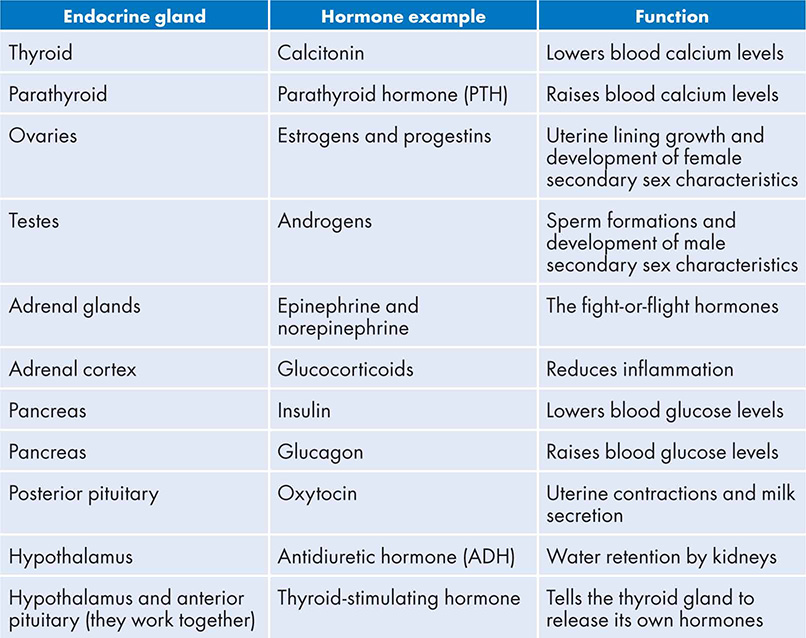
In order for a hormone to elicit a response, the target must have the correct receptors. The binding of the hormone will cause a cell response through that clever process of signal transduction we learned about in Chapter 4. This is how a chemical can travel throughout the entire body (in the circulatory system), but only have an effect at a specific location. Only cells with a complementary receptor will “hear” the message.
Here is a perfect example of hormonal regulation of homeostasis (and a reminder of our must know concept). The endocrine system uses the hormones insulin and glucagon to maintain even levels of blood sugar (glucose). Levels that are too high (hyperglycemia) or too low (hypoglycemia) can be dangerous, as are diseases that wipe out the body’s ability to regulate properly (diabetes).
The levels of glucose dissolved in the bloodstream are regulated by the pancreas. If you were so busy you forgot to eat lunch, your blood glucose levels would begin to dip below the homeostatic levels (which is about 90 mg/100 mL).
![]()
IRL
If you’ve gone to your doctor for a checkup and they ask you for a urine sample, they are doing a quick check of your blood glucose levels. They dip a specially treated test strip in the sample for a quick quantitative analysis.
The pancreas receives the signal that your body cells do not have enough glucose for cellular metabolism and your body needs to release some glucose stored in the liver. Specific cells in your pancreas (the alpha cells) release the hormone glucagon. Glucagon travels to the liver where it frees glucose monomers from the storage polymer glycogen. The freed glucose jumps into the bloodstream, restoring level conditions.
If, instead, you decided to eat an entire chocolate cake, your blood glucose levels would be too high; cells need to take in the free-floating glucose and use it in cellular respiration, or the liver needs to store it as glycogen. Different cells of the pancreas (beta cells) secrete the hormone insulin. The cells of your body have specific receptors for insulin and, once attached, they take up glucose and use it in cellular respiration. The liver also hears the call to arms, and it brings in glucose and creates the polymer glycogen (for long-term storage of glucose). This drops the blood glucose levels back down to where they should be.
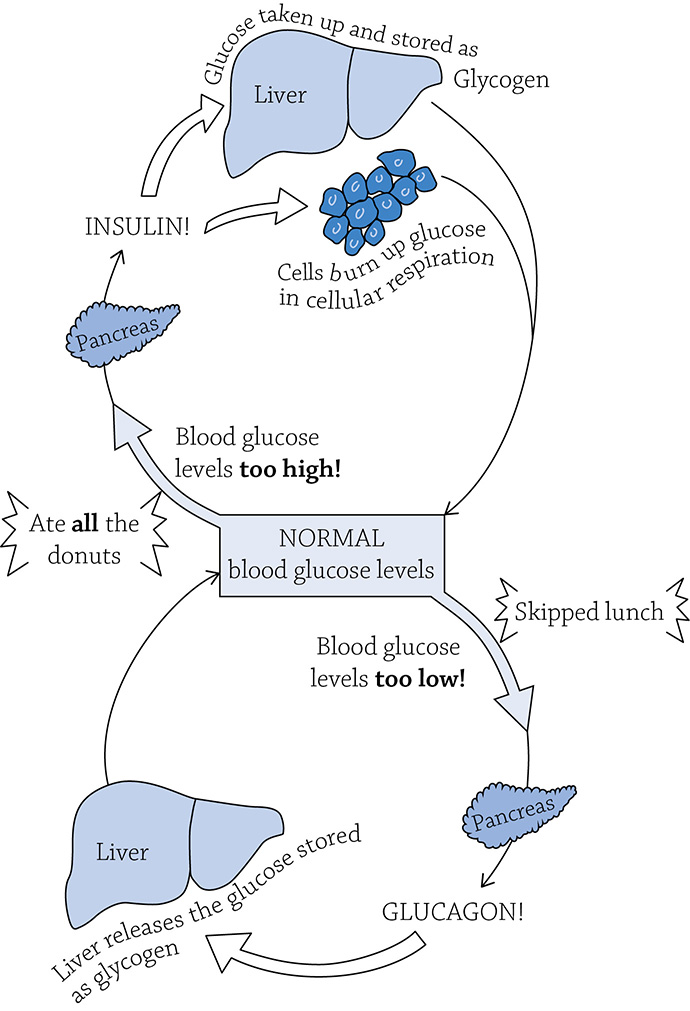
Insulin and glucagon maintaining homeostasis
Disruption of Homeostasis
Diabetes mellitus is a disease that renders the insulin signal ineffective. If your body cells cannot hear the signal to take in glucose for cellular respiration, blood glucose levels remain high and a lot of glucose is excreted in the urine (which is why urine is tested for glucose). The body cells resort to using fat as the substrate for cellular respiration, leading to acidic metabolites and dangerously low blood pH.
Why, exactly, insulin fails to work depends on the type of diabetes (I or II). Type I diabetes is called “early-onset” because people are born with this condition. The immune system attacked the beta cells and the pancreas can no longer produce insulin. A diabetic person must rely on properly timed insulin shots in order to control their glucose levels. Type II diabetes (or, insulin resistance) is referred to as “late-onset” because the likelihood of developing type II diabetes increases drastically after age 45, after decades of unhealthy eating habits. Type II diabetes is “insulin-independent” because the pancreas still produces insulin, but the cells’ receptors for the hormone are no longer properly functioning. If the body cells cannot “hear” the signal to take in glucose, this can lead to health problems. Insulin shots would not help a person with type II diabetes (making the insulin isn’t the problem); the only treatment is a carefully controlled diet.
![]()
IRL
Type II diabetes used to be extremely rare in youth, but it has become much more common in recent years. There has also been a disturbing increase in type I diabetes in people 20 years old and younger.
Osmoregulation When You Live in the Water
The process of osmoregulation maintains healthy levels of water and solutes (salts, ions) in tissues. This is important for body cells to function, including neurons (that rely on proper levels of Na+) and muscle cells (that rely on proper levels of Ca2+). Aquatic critters live in the water and must work to maintain homeostatic levels of both salt and water. A fish living in freshwater (such as a lake or a river) is surrounded by a hypotonic solution; their tissues have a lower water potential. Therefore, osmosis will occur into the fish’s body (recall that water moves from an area of HIGH water potential to LOW water potential).
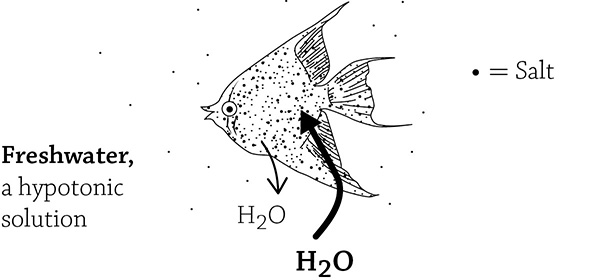
Water movement in a freshwater fish
More water will move into the fish’s body than leave it. To maintain healthy internal levels of salt and water, the fish needs to excrete large amounts of diluted (watery) urine. It must also retain as much salt as possible in its body to maintain a healthy osmotic balance; their kidneys reabsorb salt and bring it back into the circulatory system before it can be lost in the urine.
In contrast, a fish living in saltwater (the ocean) has to constantly battle water loss because the surrounding environment is hypertonic and has a lower water potential compared to the tissues.
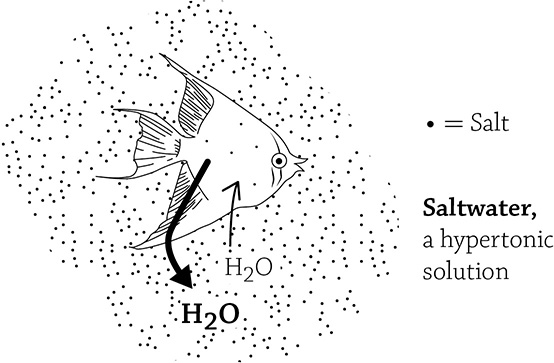
Water movement in a saltwater fish
Not only is the fish losing water, it is also taking in a ton of salt in its diet. The kidneys are going to work hard at saving water by reabsorbing it back into the circulatory system, and getting rid of as much salt as possible. Marine fish, therefore, produce a concentrated, very salty urine.
Excretion
The liquidy insides of animals need to remain free of the dangerous chemicals produced when proteins and nucleic acids are broken down. Refer back to what we learned about the four major macromolecules and consider what element is found exclusively in nucleic acids and proteins … nitrogen! Unfortunately, when nitrogenous molecules are dismantled, toxic things such as ammonia (NH3) are released. The excretory system is specialized to help remove (or, excrete) these nasty metabolic waste products (as urine). The excretory system also plays a role in osmoregulation and maintaining healthy levels of salt in the body tissues, as we just learned about.
The excretory system is not about excrement (poop). The digestive system deals with poop, which is nothing more than indigestible food and beneficial gut bacteria. The excretory system is in charge of the momentous task of cleaning your blood and removing toxic chemicals that could kill you. Our kidneys are the key organs of this process, though a tiny bit of nitrogenous waste is also excreted in our sweat. Since this nitrogen-containing waste is so toxic, different critters have evolved to produce a form of this waste that is perfect for the environment in which they live:
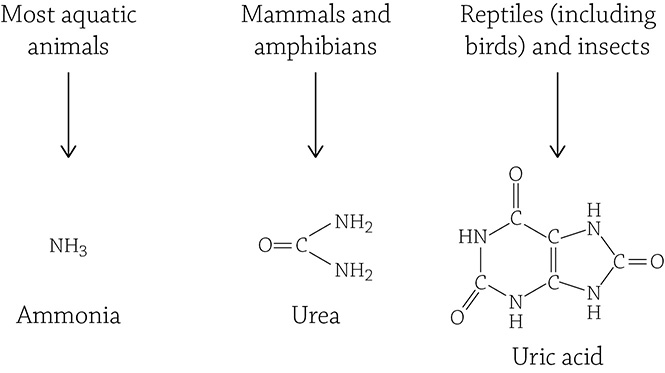
Fish have the luxury of excreting the most toxic and most concentrated form of waste: ammonia. If animals formed and collected ammonia in our bodies, we would toxify ourselves! Ammonia is, however, extremely water-soluble and is quickly whisked away from the water-dwelling animal’s body. Land animals can’t handle ammonia as our main form of nitrogenous waste, so we have evolved the less-dangerous form of urea: not as concentrated, and not as dangerous.
The most interesting adaptation, however, is excretion of uric acid. This waste product is the only form of nitrogenous waste that is a solid! If you consider the critters that evolved to use this form of nitrogenous waste, you may see something they have in common … all their young gestate in eggs. If you’re a little baby bird, bearded dragon, or bug, you are stuck in the egg’s watery environment while developing. Any water-soluble waste product would get stuck in the egg with the baby, creating a dangerously toxic solution. Therefore, the best waste product is a solid that settles on the bottom of the egg, out of harm’s way.
![]()
IRL
Ever see a bird pee a liquid? That would be no, because as we just learned, it’s a solid. If you have had a run-in with bird poop, it’s actually only half poop; the other half is a white, solid blob of uric acid.
The human kidney is an organ the size of your fist, and we have two of them nestled against the back of our body cavity. The kidneys adjust levels of water, salts, and ions in our blood, along with removing the toxic urea created by the liver. Anything to be excreted is moved from the blood into the nephrons of the kidneys. There are millions of these little structures embedded all throughout the cortex (outer layer) of the kidneys. The nephrons collect excess water, ions, and waste, and send it all down the ureters, into the bladder for storage, and eventually expelled through the urethra (as urine).
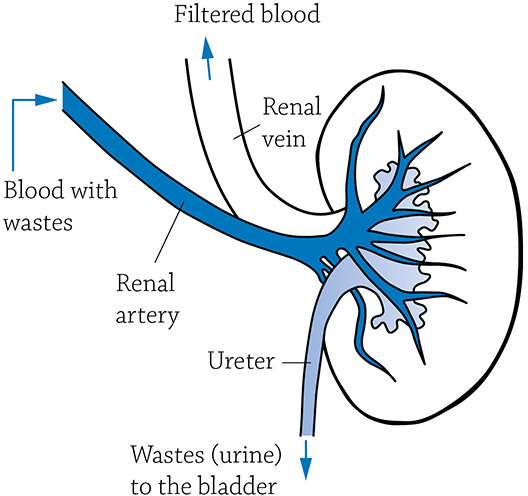
Blood flow through a kidney
Author: The National Institute of Diabetes and Digestive and Kidney Diseases. https://www.niddk.nih.gov/health-information/kidney-disease/kidneys-how-they-work
![]()
IRL
While you sit there casually reading, your heart is pumping about 5 liters of blood every minute, and 1 liter of that volume is routed through the kidneys for cleaning! And if you happen to have only one kidney (either because you were kind enough to donate one of yours to a person in need, or you simply were born with only one functioning kidney), you are still able to live a healthy, normal life.
Osmoregulation in Humans
Land animals have an extra challenge of maintaining proper osmotic levels in a dry environment. The kidneys need to quickly excrete (or reabsorb) water when needed. If water remains in the nephron’s tubule, it will be excreted as urine; if the water is moved through the nephron back into the capillaries, it will remain in the circulatory system.
Any process of moving water across a semi-permeable membrane is facilitated by these amazing little transport proteins called aquaporins. Aquaporins allow water to move across membranes at astonishing rates. The nephron can adjust the amount of water reabsorbed from the urine back into the bloodstream by temporarily adjusting the number of aquaporin proteins perforating the collecting ducts to which the nephrons are attached. This allows the body to maintain proper blood osmolarity. The signal that tells the kidneys to adjust aquaporin numbers is a hormone called ADH (antidiuretic hormone).
![]()
IRL
Alcohol and caffeine lower ADH secretion, thus decreasing the amount of water reabsorbed … and you pee more. Alcohol and coffee are, therefore, diuretics (things that make you pee), and the antidiuretic hormones counteract losing too much water in your urine.
The brain’s hypothalamus maintains proper blood osmolarity by monitoring the dilution of the blood. Imagine, if you will, that you ate an entire bag of salty potato chips while sitting in the sun and sweating profusely. The high amounts of salt and lower volume of water mean the blood has a high osmolarity. The hypothalamus responds by releasing ADH, causing a temporary increase in aquaporins. The nephron’s water permeability is increased, leading to water being reabsorbed into the bloodstream, creating concentrated urine. This is a wonderful example of negative feedback. If you drink a ton of water, your blood osmolarity is now low. Your brain realizes you need to get rid of some of that excess water, so not much ADH is released. The kidneys happily let the water flow away as dilute urine, reestablishing homeostasis once again.
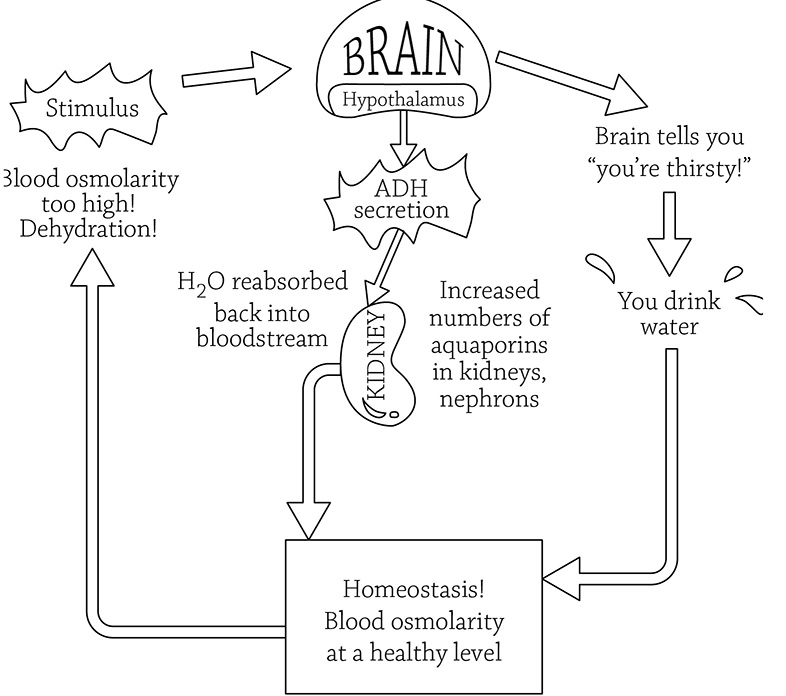
Negative feedback loop due to increased blood osmolarity, courtesy of the hypothalamus and the kidneys
REVIEW QUESTIONS
1. Why is maintaining homeostasis so important for organisms?
2. How does a positive feedback loop differ from a negative feedback loop?
3. Fill in the following table:

4. The process of maintaining proper levels of water and solutes in the blood is referred to as ____________________. The millions of small ____________________ in the kidneys are able to adjust the amount of water reabsorbed back into the bloodstream by changing the number of ____________________ proteins that line the collecting ducts. The chemical signal that leads to an increase in the numbers of these transport proteins is ____________________.
5. Fill in the blanks and choose the correct term from the given pair: When maintaining homeostatic levels of glucose in the bloodstream, the hormone ____________________ is responsible for raising/lowering blood glucose levels. One way it removes free glucose from the bloodstream is by stimulating the ____________________ to take in glucose and form the storage polymer, ____________________.
6. Why is it advantageous for birds and insects to produce uric acid as their form of nitrogenous waste?
7. If the stimulus was an increase in blood osmolarity, what two responses would occur to reestablish homeostasis?
8. Choose the correct term from the following pair and then fill in the blank: Land animals have kidneys that work more like marine/freshwater fish because land animals are also battling water loss. The kidneys save water by reabsorbing it back into the ____________________ instead of allowing too much to be excreted in the urine.
